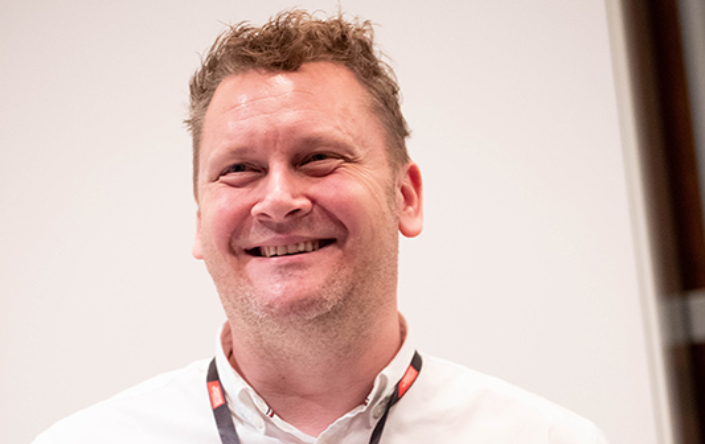
We caught up with Ben Hodgkinson, Head of Mechanical Engineering at Mercedes AMG High Performance Powertrains and the Design Challenge’s new Steering Committee Chair.
Read our full interview with Ben to find out more about his academic and career background, what he would like to achieve as Design Challenge Steering Committee Chair, his advice for students taking part in the Challenge and much more.
Q: Please tell us a bit about yourself, your academic and career background?
Ben Hodgkinson (BH): I graduated from University College London with an MEng 1st class honours in 1998. This, however, was following a rocky start with some poor A level grades which I corrected with an Engineering Foundation year from the University of Leicester in 1994. The time when I should have been studying for A levels, I fell in love with cars, which has since turned into a love for motorsports; competitive engineering at it’s best! I feel lucky to have gained my first job as a graduate at Mountune Race Engines where I helped design the WRC engine for the Ford Focus driven by the late, great, Colin McRae. A couple of years after that, I moved to Advanced Engine Research where I help the clean-sheet design of a turbo charged I4 racing engine for MG’s entry into Le Mans 24hr LMP675. Nearly 20 years ago I started at Ilmor Racing Engines which has since changed company name to Mercedes AMG High Performance Powertrains. When I first started I was designing parts for Honda’s methanol fuelled Indy Racing League engine but soon moved to the Formula 1 side of the business realising a dream of mine. I am now the Head of Mechanical Engineering and my department are responsible for designing and developing the Internal Combustion Engine for Mercedes Formula 1.
Q: What are some of the highlights of working within Formula 1 at Mercedes AMG HPP over the last 19 years?
BH: There have been numerous highlights but probably the most satisfying season was 2014. We had been working hard for a number of years preparing for the start of the hybrid era and our competitors were fierce. We had no idea where we would be in the pecking order until we started racing. This season we won both Drivers and Constructors championships and had a clear advantage to the rest of the field. Our hard work, blood, sweat and tears had paid off. This has since turned into the longest ever winning spree of seven double world championships, which is something I’ll be immensely proud of forever.
Q: What experience from Mercedes AMG HPP are you looking to bring to your new role as Design Challenge Steering Committee Chair?
BH: The Design Challenge is directly analogous to motorsport and Formula 1. Engineers are given a set of rules where they must use their ingenuity and skill to design and create a better solution than their competitors, these will then compete on ‘race day’. The rules and budget are different but the essence is identical. I believe, motorsport is important to engineering due to the rate of innovation it produces. This is why the FIA intentionally write the rules to generate innovation in a direction that is relevant to wider industry. I intend to further strengthen the analogy by keeping the competition fierce and by changing the Challenge rules to keep the technology relevant to the future of engineering.
Q: What motivated you to apply for the Design Challenge Steering Committee Chair role?
BH: I have been involved in the Design Challenge for a number of years as a judge and keynote speaker. During the competitions I have witnessed some incredible engineering skill and truly inspired innovation. It made me realise how important the competition is and how it can discover amazing engineering talent of the future. It’s The X Factor for engineers! I had to be a part of that and am looking forward to help shape it’s future.
Q: What is your vision for the Design Challenge and what would you like to achieve during your tenure as Design Challenge Steering Committee Chair?
BH: There are two main things that I want to achieve; firstly I want to bring the Challenge up to date and as relevant as possible to tomorrow’s technology. If done right we can help to discover the engineering talent that will solve the biggest issue which faces the engineering industry, the environment and sustainability. Also I want to increase the level of diversity in engineering, not only the right thing to do for humankind but essential for diverse innovation.
Q: What advice/top tips would you like to give specifically to the competing teams?
BH: Maximise every single of the quantitative rules. Work out what the quantifiable differentiator is for your particular competition (in F1 it’s laptime). Then ask yourself whether each specific rule should be maximised or minimised in order to make your creation the most competitive. Maximum power motor, minimum weight vehicle and any budget left shows a lack of imagination.
Q: What would you say to young engineers who are thinking of entering the Challenge?
BH: If you’re a competitive and creative engineer the Institution’s Design Challenge will be up there with the most fun you’ve ever had. Also, it’s exactly the sort of thing myself and employers like me would like to read about in the CVs of serious candidates. It can really differentiate you from the competition.